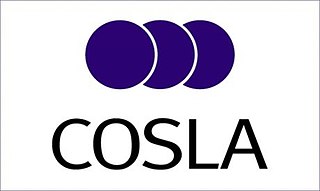The Electronic Check Council (ECC) is a US organization that provides a forum for stakeholders of NACHA-The Electronic Payments Association to design, propose, monitor, and promote solutions that enable the conversion of paper checks to electronic entries.
The council was founded in 1995 and currently has more than 140 members, including financial institutions, vendors, retailers, processors, networks and associations.[ citation needed ]
Developments at the ECC all start with discussion and development of solutions in small group settings. These smaller groups are designated as work groups and ad hoc groups that focus on specific areas of electronic check development.
A work group is an ongoing group that tackles a number of issues over a period of time related specifically either to a particular Standard Entry Class Code (such as POP, ARC, etc.) or to a specific topic that impacts all eCheck Standard Entry Class Codes (such as marketing).
An ad hoc group (or subgroup) tackles one specific issue and disbands once the issue has been resolved.
Software testing is the act of examining the artifacts and the behavior of the software under test by verification and validation. Software testing can also provide an objective, independent view of the software to allow the business to appreciate and understand the risks of software implementation. Test techniques include, but are not limited to:

In computer networking, a wireless access point, or more generally just access point (AP), is a networking hardware device that allows other Wi-Fi devices to connect to a wired network or wireless network. As a standalone device, the AP may have a wired connection to a switch or router, but, in a wireless router, it can also be an integral component of the router itself. An AP is differentiated from a hotspot, which is a physical location where Wi-Fi access is available.

Health informatics is the study and implementation of computer structures and algorithms to improve communication, understanding, and management of medical information. It can be viewed as branch of engineering and applied science.

In systems engineering and software engineering, requirements analysis focuses on the tasks that determine the needs or conditions to meet the new or altered product or project, taking account of the possibly conflicting requirements of the various stakeholders, analyzing, documenting, validating and managing software or system requirements.
In computer programming, a software framework is an abstraction in which software, providing generic functionality, can be selectively changed by additional user-written code, thus providing application-specific software. It provides a standard way to build and deploy applications and is a universal, reusable software environment that provides particular functionality as part of a larger software platform to facilitate the development of software applications, products and solutions.

A Data Matrix is a two-dimensional code consisting of black and white "cells" or dots arranged in either a square or rectangular pattern, also known as a matrix. The information to be encoded can be text or numeric data. Usual data size is from a few bytes up to 1556 bytes. The length of the encoded data depends on the number of cells in the matrix. Error correction codes are often used to increase reliability: even if one or more cells are damaged so it is unreadable, the message can still be read. A Data Matrix symbol can store up to 2,335 alphanumeric characters.

The Convention of Scottish Local Authorities (COSLA) is the national association of Scottish councils and acts as an employers' association for its 32 member authorities.

A hardware security module (HSM) is a physical computing device that safeguards and manages secrets, performs encryption and decryption functions for digital signatures, strong authentication and other cryptographic functions. These modules traditionally come in the form of a plug-in card or an external device that attaches directly to a computer or network server. A hardware security module contains one or more secure cryptoprocessor chips.
An entity–attribute–value model (EAV) is a data model optimized for the space-efficient storage of sparse—or ad-hoc—property or data values, intended for situations where runtime usage patterns are arbitrary, subject to user variation, or otherwise unforeseeable using a fixed design. The use-case targets applications which offer a large or rich system of defined property types, which are in turn appropriate to a wide set of entities, but where typically only a small, specific selection of these are instantiated for a given entity. Therefore, this type of data model relates to the mathematical notion of a sparse matrix. EAV is also known as object–attribute–value model, vertical database model, and open schema.
Communications servers are open, standards-based computing systems that operate as a carrier-grade common platform for a wide range of communications applications and allow equipment providers to add value at many levels of the system architecture.
The Integral SatCom Initiative (ISI) was an Information and Communications Technologies (ICT) European Technology Platform (ETP) led by the European SatCom industry and supported by the European Commission to address Satellite Communications (SatCom) strategic research and innovation challenges. It gathered approximately 200 member organisations representing all the stakeholders of the European SatCom sector from 29 different countries. It included members from manufacturing industry, network operations and service provision, SMEs, research centres and academia, European and National Institutions. Some international research entities do also participate. In 2013, after a public call by the European Commission to re-structure ETPs to better fit Horizon 2020 interests, ISI formally merged with Net!Works ETP to form NetWorld ETP, bringing together almost 1,000 partner organisations. NetWorld would become the partner ETP in the contractual public-private innovation partnership on 5G Infrastructures with the EU in December 2013.
Gigabit Home Networking (G.hn) is a specification for wired home networking that supports speeds up to 2 Gbit/s and operates over four types of legacy wires: telephone wiring, coaxial cables, power lines and plastic optical fiber. Some benefits of a multi-wire standard are lower equipment development costs and lower deployment costs for service providers.
The Certification Authority Browser Forum, also known as the CA/Browser Forum, is a voluntary consortium of certification authorities, vendors of Internet browser and secure email software, operating systems, and other PKI-enabled applications that promulgates industry guidelines governing the issuance and management of X.509 v.3 digital certificates that chain to a trust anchor embedded in such applications. Its guidelines cover certificates used for the SSL/TLS protocol and code signing, as well as system and network security of certificate authorities.
Design for All in the context of information and communications technology (ICT) is the conscious and systematic effort to proactively apply principles, methods and tools to promote universal design in computer-related technologies, including Internet-based technologies, thus avoiding the need for a posteriori adaptations, or specialised design.

The Body of European Regulators for Electronic Communications (BEREC) is the body in which the regulators of the telecommunications markets in the European Union work together. Other participants are the representatives of the European Commission, as well as telecommunication regulators from the member states of the EEA and of states that are in the process of joining the EU.
The International Association of Insurance Supervisors (IAIS) is a voluntary membership organization of insurance supervisors from more than 200 jurisdictions, constituting 97% of the world's insurance premiums. It is the international standards-setting body for the insurance sector. The IAIS was established in 1994 and operates as a verein, a type of non-profit organisation under Swiss Civil Law.

Wind Powering America (WPA) is an initiative of the United States Department of Energy (DOE) that seeks to increase the use of wind energy throughout the United States. WPA collaborates with key state and regional stakeholders, including farmers, ranchers, Native Americans, rural electric cooperatives, consumer-owned utilities, and schools to break down barriers associated with wind energy development.
The United Nations Guidelines for Consumer Protection (UNGCP) relate to consumer protection goals. The statement supplied is that the guidelines are "a valuable set of principles for setting out the main characteristics of effective consumer protection legislation, enforcement institutions and redress systems and for assisting interested Member States in formulating and enforcing domestic and regional laws, rules and regulations that are suitable to their own economic and social and environmental circumstances, as well as promoting international enforcement cooperation among Member States and encouraging the sharing of experiences in consumer protection."

The Bali Process is an official international forum, established in 2002, to facilitate discussion and information sharing about issues relating to people smuggling, human trafficking, and related transnational crime and appropriate responses to these issues.
Multistakeholder governance is a practice of governance that employs bringing multiple stakeholders together to participate in dialogue, decision making, and implementation of responses to jointly perceived problems. The principle behind such a structure is that if enough input is provided by multiple types of actors involved in a question, the eventual consensual decision gains more legitimacy, and can be more effectively implemented than a traditional state-based response. While the evolution of multistakeholder governance is occurring principally at the international level, public-private partnerships (PPPs) are domestic analogues.